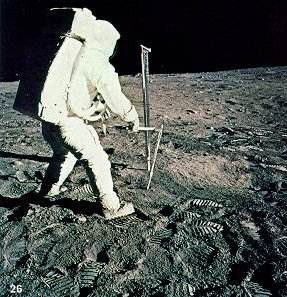The First Lunar Landing
PART III
ARMSTRONG
We had very little trouble, much less trouble than expected
on the surface. It was a pleasant operation. Temperatures
weren't high. They were very comfortable.
The little EMU, the combination of spacesuit
and back pack that provided or sustained our life
on the surface, operated magnificently, We had no cause for
concern at any time with the operation of that equipment.
The primary difficulty that we observed was that there
was just far too little time to do the variety of things
that we would have liked to have done. In earlier pictures,
you saw rocks and the boulder field out Buzz's window
that were 3 and 4 feet in size -- very likely pieces of the
lunar bedrock. And it would have been very interesting
to go over and get some samples of those, There were other
craters that differed widely, that would have been
interesting to examine and photograph. We had the problem of
the five-year-old boy in a candy store. There are just
too many interesting things to do. The surface as we said was
fine-grained with lots of rock in it. It took footprints
very well, and the footprints stayed in place. (Photo 17.) The
LM was in good shape, and it exhibited no damage
from the landing or the descent. Here is a picture of the ladder
with the well-known plaque on the primary strut. (Photo 18.)
There was a question as to whether the LM would sink
in up to its knees. It didn't, as you can see.
The footpads sunk in, perhaps, an inch or two. And the probe in this
picture was folded over and sticks up through the sand
in the bottom right-hand corner (Photo 19) showing that we
were traveling slightly sidewise at touchdown. There was
a wide variety of surfaces. Here Buzz is standing in a
small crater (Photo 20), and gives a very good picture
of the rounded rims of what we believe are very old features.
The LM was in a relatively smooth area between the craters
and the boulder field. (Photo 21.) And we had some
difficulty in determining just what straight up and down
was. Our ability to pick out straight up and down was
probably several degrees less accurate than it is here
on Earth. And it caused some difficulty in having things like
our cameras and scientific experiments maintain the level
attitude we expected.
ALDRIN
The two experiments that you saw in the previous picture
were deployed in the Scientific Equipment Bay.
We found that getting them down produced no significant
problem. And here you see a view of my carrying these
two experiments out to the deployment site (Photo 22),
about 70 feet south of the lunar module. You have a very
good view of the varying depths of the upper surface layer.
You see that along the crater rim -- a small crater rim off
to my left -- along this, the upper surface appears to be about
2 to 3 inches. The subsurface has a slope that is rather
ill-defined, and one has to be very careful in treading
around these small 12 craters. Any long excursions, I feel,
would take a good bit of attention in moving along
to avoid walking along or down the
slope of some of these smaller craters. This is the
Passive Seismic Experiment (Photo 23) that was deployed
and has been giving us good returns on the interactions
of the Moon. We had a little difficulty deploying one of
the panels. I had to move around to
the far side and release the restraining lever, and then
the second panel came out. We had a little
bit of difficulty determining, as
Neil said, the exact local horizontal, and I think this is
due to the decrease in the cues, that a person has as to
which way up really is. One has to lean a little bit more
off to the side before you get this body cue that your
approaching off-balance,
and of course the surface varied considerably in this
area. This second experiment is the Laser Reflector. (Photo 24.)
We've been successful in bouncing Laser beams off this,
from its hundred arrays of reflectors. The other
experiment, the Solar Wind Experiment (Photo 25), you
can see, was deployed quite early in the flight and was
rolled up, just one of the last things before I reentered
the LM. In this picture, you see me driving the core tube
into the surface. (Photo 26.) We collected two different core
tube samples. It was quite surprising, the resistance that
was met in this subsurface medium, and at the same time,
you see that it did not support very well the core tube as
I was driving it into the surface.



















